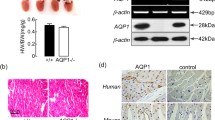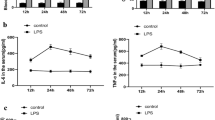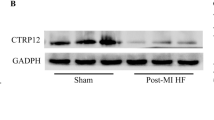Abstract
The aim of this study was to investigate the regulation mechanism of aquaporin 9 (AQP9) gene on inflammatory response and cardiac function in rats with myocardial infarction (MI) through extracellular signal-regulated kinase1/2 (ERK1/2) pathway. The constructed rats models of MI were randomly divided into 6 groups: control group (sham operation group, MI modeling sham operation), model group (MI modeling), NC group (MI modeling, tail vein injection of AQP9 negative control sequence vector), AQP9 shRNA group (MI modeling, tail vein injection of AQP9 shRNA plasmid vector), U0126 group (MI modeling, tail vein injection of ERK signaling pathway inhibitor), and AQP9 shRNA + U0126 group. The hemodynamics and cardiac function of rats in each group were detected on the seventh day of modeling. The levels of AQP9 and inflammatory factors [tumour necrosis factor-α (TNF-α), interleukin-6 (IL-6), interleukin-10 (IL-10)] in peripheral blood of rats were detected by ELISA method. qRT-PCR and western blot were used to detect the mRNA and protein expression of AQP9, ERK1/2, B-cell lymphoma-2 (Bcl-2), Bcl-associated x (Bax) in the myocardial tissue of rats. TTC and TUNEL staining were used to observe myocardial infarct size and apoptosis of myocardial cells in each group. Compared with control group, the levels of heart rate, left ventricular end-diastolic pressure, TNF-α, and IL-6 were increased in each group of rats with MI (all p < 0.05), while the levels of systolic blood pressure, diastolic blood pressure, mean arterial pressure, left ventricular systolic pressure, and IL-10 were significantly decreased (all p < 0.05). The mRNA and protein expression levels of AQP9, ERK1/2 phosphorylation and Bax were significantly increased, as well as the myocardial infarct size, apoptosis index of myocardial tissue (all p < 0.05), the mRNA and protein expression levels of Bcl-2 were significantly decreased (all p < 0.05). The AQP9 gene knock-down or exogenous administration of the ERK1/2 inhibitor U0126 could improve the above indexes. However, the combination of AQP9 gene knock-down and U0126 showed no further effect. Silencing AQP9 gene can inhibit the activation of ERK1/2 signaling pathway, attenuate the inflammatory response in rats with MI, inhibit apoptosis of myocardial cells, and improve cardiac function.








Similar content being viewed by others
References
Bainey KR, Fresco C, Zheng Y, Halvorsen S, Carvalho A, Ostojic M, Goldstein P, Gershlick AH, Westerhout CM, Van de Werf F, Armstrong PW, Investigators STREAM (2016) Implications of ischaemic area at risk and mode of reperfusion in ST-elevation myocardial infarction. Heart 102:527–533
Goto Y, Ishida M, Yamada A, Uno M, Nakamori S, Nagata M, Ichikawa Y, Kitagawa K, Ito M, Sakuma H (2016) Native T1 mapping allows for the accurate detection of the segments with chronic myocardial infarction in patients with known or suspected coronary artery disease. J Cardiovasc Magn Reson 18:70
Orlic D, Ostojic MC, Labudovic M (2015) TCT-245 The randomized physiologic assessment of thrombus aspiration in patients with acute myocardial Infarction with ST-segment slevation (PATA STEMI) trial: final results. J Am Coll Cardiol 66:B42–B43
Ouweneel DM, Eriksen E, Sjauw KD, van Dongen IM, Hirsch A, Packer EJ, Vis MM, Wykrzykowska JJ, Koch KT, Baan J, de Winter RJ, Piek JJ, Lagrand WK, de Mol BA, Tijssen JG, Henriques JP (2017) Percutaneous mechanical circulatory support versus intra-aortic balloon pump in cardiogenic shock after acute myocardial infarction. J Am Coll Cardiol 69:278–287
Pascual-Gil S, Simón-Yarza T, Garbayo E, Prosper F, Blanco-Prieto MJ (2015) Tracking the in vivo release of bioactive NRG from PLGA and PEG-PLGA microparticles in infarcted hearts. J Control Release 220:388–396
Greenberg H, McMaster P, Dwyer EM Jr (1984) Left ventricular dysfunction after acute myiocardial infarction: results of a prospective multicenter study. J Am Coll Cardiol 4:867–874
Alam MA, Subhan N, Rahman MM, Uddin SJ, Reza HM, Sarker SD (2014) Effect of citrus flavonoids, naringin and naringenin, on metabolic syndrome and their mechanisms of action. Adv Nutr 5:404–417
Meli R, Pirozzi C, Pelagalli A (2018) New perspectives on the potential role of aquaporins (AQPs) in the physiology of inflammation. Front Physiol 9:101
Sang YL, Nam YK, Yi KK (2017) Characterization and expression profiles of aquaporins (AQPs) 1a and 3a in mud loach Misgurnus mizolepis, after experimental challenges. Fish Aquat Sci 20:23
Cui X, Zhang J, Li Y, Sun Y, Cao J, Zhao M, Zhao Y, Zhao X, He Y, Han A (2015) Effects of Qili Qiangxin capsule on AQP2, V2R, and AT1R in rats with chronic heart failure. Evid Based Complement Alternat Med 2015:639450
Chen Q, Zhu L, Zheng B, Wang J, Song X, Zheng W, Wang L, Yang D, Wang J (2016) Effect of AQP9 expression in androgen-independent prostate cancer cell PC3. Int J Mol Sci 17:E738
Thuny F, Textoris J, Amara AB, Filali AE, Capo C, Habib G, Raoult D, Mege JL (2012) The gene expression analysis of blood reveals S100A11 and AQP9 as potential biomarkers of infective endocarditis. PLoS One 7:e31490
Sun SJ, Wu XP, Song HL, Li GQ (2015) Baicalin ameliorates isoproterenol-induced acute myocardial infarction through iNOS, inflammation, oxidative stress and P38MAPK pathway in rat. Int J Clin Exp Med 8:22063–22072
Gao E, Lei YH, Shang X, Huang ZM, Zuo L, Boucher M, Fan Q, Chuprun JK, Ma XL, Koch WJ (2010) A novel and efficient model of coronary artery ligation and myocardial infarction in the mouse. Circ Res 107:1445–1453
Vukomanovic V, Tadic M, Suzic-Lazic J, Kocijancic V, Celic V (2017) The relationship between heart rate variability and left ventricular layer-specific deformation in uncomplicated diabetic patients. Int J Cardiovasc Imaging 33:481–490
Shah AM, Claggett B, Sweitzer NK, Shah SJ, Anand IS, Liu L, Pitt B, Pfeffer MA, Solomon SD (2015) Prognostic importance of impaired systolic function in heart failure with preserved ejection fraction and the impact of spironolactone. Circulation 132:402–414
Tan J, Hua Q (2012) Correlations between serum inflammation factors and left ventricular remodeling in acute ST segment elevation myocardial infarction. Yonsei Med J 53:501–507
Arini PD, Valverde ER (2016) Beat-to-beat electrocardiographic analysis of ventricular repolarization variability in patients after myocardial infarction. J Electrocardiol 49:206–213
Ren J, Li C, Liu Y, Liu H, Dong Z (2018) Protective effect of dexmedetomidine against myocardial ischemia-reperfusion injury in rabbits. Acta Cir Bras 33:22–30
Yeh CF, Wang CH, Tsai PR, Wu CK, Lin YH, Chen YS (2015) Use of extracorporeal membrane oxygenation to rescue patients with refractory ventricular arrhythmia in acute myocardial infarction. Medicine (Baltimore) 94:e1241
Wan N, Liu X, Zhang XJ, Zhao Y, Hu G, Wan F, Zhang R, Zhu X, Xia H, Li H (2015) Toll-interacting protein contributes to mortality following myocardial infarction through promoting inflammation and apoptosis. Br J Pharmacol 172:3383–3396
Carbone F, Nencioni A, Mach F, Vuilleumier N, Montecucco F (2013) Pathophysiological role of neutrophils in acute myocardial infarction. Thromb Haemost 110:501–514
Montecucco F, Bauer I, Braunersreuther V, Bruzzone S, Akhmedov A, Lüscher TF, Speer T, Poggi A, Mannino E, Pelli G, Galan K, Bertolotto M, Lenglet S, Garuti A, Montessuit C, Lerch R, Pellieux C, Vuilleumier N, Dallegri F, Mage J, Sebastian C, Mostoslavsky R, Gayet-Ageron A, Patrone F, Mach F, Nencioni A (2013) Inhibition of nicotinamide phosphoribosyltransferase reduces neutrophil-mediated injury in myocardial infarction. Antioxid Redox Signal 18:630–641
Riesenberg K, Levy R, Katz A, Galkop S, Schlaeffer F (1997) Neutrophil superoxide release and interleukin 8 in acute myocardial infarction: distinction between complicated and uncomplicated states. Eur J Clin Invest 27:398–404
Tu XK, Yang WZ, Chen JP, Chen Y, Chen Q, Chen PP, Shi SS (2015) Repetitive ischemic preconditioning attenuates inflammatory reaction and brain damage after focal cerebral ischemia in rats: involvement of PI3K/Akt and ERK1/2 signaling pathway. J Mol Neurosci 55:912–922
Lv H, Zhu C, Liao Y, Gao Y, Lu G, Zhong W, Zheng Y, Chen W, Ci X (2015) Tenuigenin ameliorates acute lung injury by inhibiting NF-κB and MAPK signalling pathways. Respir Physiol Neurobiol 216:43–51
Guo C, Ma L (2015) TCTAP A-027 Panax Notoginseng Saponins safely boost cardiac function and anti-apoptosis in a myocardial infarction model in the RAT via the MEK/ERK1/2 pathway. J Am Coll Cardiol 65:S12
Xiao J, She Q, Wang Y, Luo K, Yin Y, Hu R, Huang K (2009) Effect of allopurinol on cardiomyocyte apoptosis in rats after myocardial infarction. Eur J Heart Fail 11:20–27
Liu Y, Yang H, Liu LX, Yan W, Guo HJ, Li WJ, Tian C, Li HH, Wang HX (2016) NOD2 contributes to myocardial ischemia/reperfusion injury by regulating cardiomyocyte apoptosis and inflammation. Life Sci 149:10–17
Liu M, Wang XR, Wang C, Song DD, Liu XH, Shi DZ (2013) Panax quinquefolium saponin attenuates ventricular remodeling after acute myocardial infarction by inhibiting chop-mediated apoptosis. Shock 40:339–344
Zhang D, Zhu L, Li C, Mu J, Fu Y, Zhu Q, Zhou Z, Liu P, Han C (2015) Sialyltransferase7A, a Klf4-responsive gene, promotes cardiomyocyte apoptosis during myocardial infarction. Basic Res Cardiol 110:28
Acknowledgements
This work was supported by National Natural Science Foundation of China (81700298).
Author information
Authors and Affiliations
Corresponding author
Ethics declarations
Conflict of interest
The authors declare that they have no conflict of interest.
Ethical approval
This experiment was approved by the Animal Ethics Committee of The First Affiliated Hospital of Soochow University. All animal experiments followed the Declaration of Helsinki. All applicable international, national, and/or institutional guidelines for the care and use of animals were followed.
Additional information
Publisher's Note
Springer Nature remains neutral with regard to jurisdictional claims in published maps and institutional affiliations.
Rights and permissions
About this article
Cite this article
Huang, X., Yu, X., Li, H. et al. Regulation mechanism of aquaporin 9 gene on inflammatory response and cardiac function in rats with myocardial infarction through extracellular signal-regulated kinase1/2 pathway. Heart Vessels 34, 2041–2051 (2019). https://doi.org/10.1007/s00380-019-01452-8
Received:
Accepted:
Published:
Issue Date:
DOI: https://doi.org/10.1007/s00380-019-01452-8




